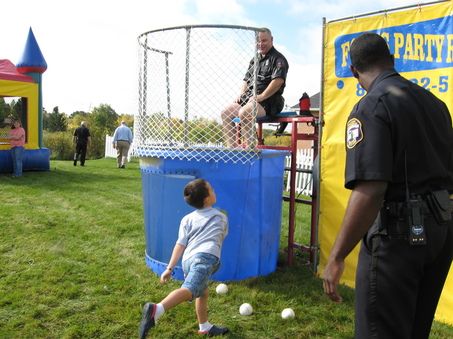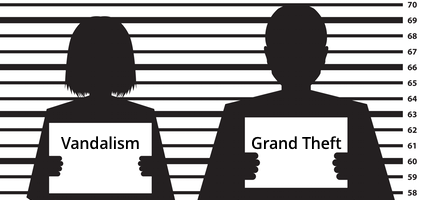In recent years, incidences of violent crime and homicide in Chicago, Illinois have risen exponentially. According to the Chicago Police Department (2017), during the past 12 months 27,719 violent crimes have been reported, including 705 homicides. During 2016, the rate of homicide rose nearly 50 percent, with 90 murders in the month of August alone (Davey, 2016). The United States Census Bureau (n.d.) reports that the number of individuals living in poverty during 2011 through 2015 in Chicago was 22.3% and that the area is densely populated with 11,841.8 people per square mile in the city. As of 2016, over 50% of Chicago residents are minorities (Suburban Stats, n.d.). The significance of this information will be discussed through the lens of strain theory.

CHICAGO, IL. USA. September 2014
The premise of strain theory is that a something or someone in a person’s life is causing the strain that leads them to commit a crime in order to alleviate that strain (Agnew, 2001). One such strain is real or perceived injustice. Whether the unjust situation is a result of their own actions or hundreds of years of systematic oppression, a person who engages in criminal behavior may rationalize their actions by considering that they themselves have been mistreated. Though the days of slavery are in the past and we are no longer living in the Civil Rights Era of the 1960s, racial injustice continues to exist and is a source of discontent for many people in Chicago and other areas, including criminals.
Another factor is the magnitude of the strain, which refers to how impactful the crime is in comparison to the consequences of not committing that crime (Agnew, 2001). For example, robbing an individual may seem like a low-level crime that isn’t likely to have a lasting effect on that person but, without the money that the criminal obtains from the robbery, they may lose their homes, vehicles, ability to care for their children, or something else that will have long-term consequences for them. As mentioned earlier, 22.3% of Chicago lives in poverty (United States Census Bureau, n.d.), which means that financial strain is a major, long-lasting strain on many individuals. The criminal may feel that financial strain can be remedied, at least in the short-term, by committing robbery or theft.
Low social control is another element of strain theory, which concerns individual circumstances that a person has little or no control over, such as lack of job opportunities and available housing (Agnew, 2001). As previously stated, poverty levels in Chicago are high, and the city is densely populated. One can surmise that, with many people vying over available and affordable living spaces in such a small area, there will be some who are cannot obtain a residence. The average cost of rent per year is approximately $11,580 and home mortgages cost $22,308, while the average income is $29,486. The discrepancy between income and cost of living, which are largely out of a person’s control, are likely to cause strain that cannot easily be alleviated through legal means. The notion that meritocracy, defined by Schneider, Gruman, and Coutts (2012) as the notion that hard work will yield equal and fair results for all who work hard, is simply not accurate all of the time. Therefore, this type of strain could motivate an individual to commit crimes such as robbery and theft in order to get money to pay for the cost of living when their occupations fail to provide enough financial stability.
The final strain is pressure or incentive to engage in criminal activity in order to cope. Anderson (2009, as cited in Agnew 2001), suggests that inner-city communities may engage in criminal coping as a response to conflicts within the community and with police. In such a situation, law enforcement may not be able to help these individuals solve this problem through legitimate channels, so they take matters into their own hands. For them, criminal coping is the only way to deal with this problem. The matter of disrespectful treatment harkens back to topics of injustice and high-magnitude strains, since the situation involves unjust treatment with highly impactful consequences. Therefore, people may engage in criminal activity in order to resolve the issue of someone mistreating them by violently attacking or even killing another.
In the city of Chicago, violent crime is an extensive problem that most certainly needs to be addressed. One obvious solution is incarceration, but it is expensive and often ineffective. Prisons, jails, probation, and parole services cost the United States $81 billion annually (Wagner & Rabuy, 2017). Additionally, in the United States, up to 58 percent of violent offenders are arrested for a similar crime within 5 years of being released from prison, with the highest incidence of reincarceration being African American males (Bureau of Justice Statistics, 2014). Recent reports show that number is even higher in the city of Chicago, with over 87 percent of murder offenders having been arrested prior to committing homicide (Chicago Police Department, 2012). If incarceration is not effective, what other courses of action may be taken to deter violent crime in Chicago?
Considering Agnew’s (2001) strain theory, there are several potential strains that are complex, and there will be no simple solutions. Poverty, low job and housing availability, and institutionalized racial oppression are not problems that can be solved overnight, if ever at all. The strain of pressure or incentive to engage in criminal activity, particularly the unwillingness to contact police about disputes, may be dealt with in several ways. First, law enforcement officials may benefit from diversity training both prior to employment and periodically throughout their tenure. They may also gain the confidence of residents by interacting with them outside of regular police calls. Contact hypothesis (Schneider, Gruman & Coutts, 2012) suggests that prejudice can be remedied when two groups work together, as equals, to achieve a common goal. Police and neighborhood residents could take part in fund raisers to help pay for improvements in their community that would benefit regular citizens as well as law enforcement, so they would be cooperating with one another to achieve a common goal. Since the perception of equality is sufficient, law enforcement could dress in civilian clothing for fund raisers and act as partners rather than authority figures. These positive interactions could help them understand one another better and foster unity between law enforcement and residents. Additionally, if Chicago residents feel confident that law enforcement will work with them rather than having to rely on resolving conflicts on their own, this may help to alleviate some of the strain of perceived racial injustice.

The rate of violent crime in Chicago is staggering, and the loss of life is great. Through understanding and implementing appropriate strategies, perhaps progress can be made.
References:
Chicago Police Department CLEARMAP – Crime Summary. Retrieved March 10, 2017, from http://gis.chicagopolice.org/CLEARMap_crime_sums/startPage.htm#
Davey, M. (2016, September 1). Chicago Has Its Deadliest Month in About Two Decades. New York Times. Retrieved March 10, 2017, from https://www.nytimes.com/2016/09/02/us/chicago-august-homicides.html
United States Census Bureau QuickFacts: Chicago city, Illinois. (n.d.). Retrieved March 11, 2017, from https://www.census.gov/quickfacts/table/IPE120215/1714000
Agnew, R. (2001). Building on the foundation of general strain theory: Specifying the types of strain most likely to lead to crime and delinquency. Journal of research in crime and delinquency, 38(4), 319-361.
Suburban Stats: Population Demographics for Chicago, Illinois in 2016 and 2017 (n.d.). Retrieved March 9, 2017, from https://suburbanstats.org/population/illinois/how-many-people-live-in-chicago
Schneider, F. W., Gruman, J. A., & Coutts, L. M. (2012). Applied social psychology: understanding and addressing social and practical problems. Los Angeles: Sage.
Wagner, P., & Rabuy, B. (2017, January 25). Following the Money of Mass Incarceration. Retrieved March 10, 2017, from https://www.prisonpolicy.org/reports/money.html
Bureau of Justice Statistics: 3 in 4 Former Prisoners in 30 States Arrested Within 5 Years of Release. (2014, April 22). Retrieved March 11, 2017, from https://www.bjs.gov/content/pub/press/rprts05p0510pr.cfm
Chicago Police Department 2011 Chicago Murder Analysis. (2012). Retrieved March 10, 2017, from http://home.chicagopolice.org/wp-content/uploads/2014/12/2011-Murder-Report.pdf
Ortiz, C. J. (2014). [Untitled photo of Chicago, IL. USA]. September 2014. Retrieved from http://projects.aljazeera.com/2014/chicago-homicides/ortiz_photos.html
[Untitled photo of police fundraiser]. Retrieved from https://www.pinterest.com/pin/316870523753045552/
















